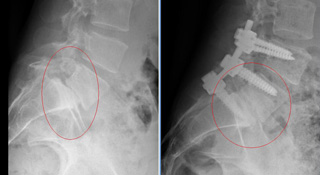It consists of the anterior or posterior “displacement” of a vertebra in relation to the vertebra below. There is a grading system for severity slip: • Grade I: 0-25% slip
- Grade II: 25-50% slip
- Grade III: 50-75% slip
- Grade IV: 75-100% slip
- Grade V or VERTEBRAL PTOSIS (over 100%): when the vertebra completely falls off the supporting vertebra. It is the highest degree of displacement.
The last three grades belong to the group called High-grade Spondylolisthesis.
The cause of this displacement is due to an anomaly or malformation in the posterior elements of the vertebra. There are different variations that gather around three main causes of Spondylolisthesis.
- Isthmic spondylolisthesis: It is the most common form. There is a defect of fusion in the posterior arch (a portion of the vertebra) called the pars interarticularis or isthmus vertebrae. It is also caused by a fracture at that level.
- Congenital/ Dysplastic spondylolisthesis: It is a malformation of the lumbosacral junction at L5 vertebra level and/or sacrum that allows to slip forward, alterations at L5 vertebra level and/or sacrum, in particular the posterior joints. It is very common in High-grade Spondylolisthesis.
- Degenerative spondylolisthesis: The ageing process of the elemnts around the spine bone makes that posterior joints fail, causing the slippage of the vertebra (invertebral disks, ligamentum flavum weakness, cartilage degeneration...etc.). It is more common at L4-L5 level. In general it doesn't cause an important slippage and it is usually grade I or II.
The most common sympton of spondylolisthesis is lower back pain with intermittent pain to the legs when the slippage of the vertebra is important. It compresses the nerve root at its exit through the conjunction foramen. The patient usually suffers from decreased range of motion of the lower back, instability or even “creaks” when doing the flexing of the torso.
Severe compression can cause loss of control of bowel, bladder function or cauda equina syndrome. It is also possible to see visible signs like a “notch” at lumbosacral level. It will affect the way you walk and the normal position of your body.
When may surgery be needed?
- When conservative treatment fails based on analgesia, physical therapy or temporary use of jacket/corset, at low-grade levels (I-II).
- If there is a lesion in the nerve roots, with sciatica clinic, strength loss and sensory alterations in legs.
- Slippage that gets worse in due time.
- Uncontrollable pain
- In general, it is suggested a systematic intervention for spondylolisthesis in grade II or higher.
What does a Spondylolisthesis Surgery look like?
The surgery involves a posterior decompression, withdrawing the lamina (posterior part of the vertebra) partially or totally. Everything that may compress the nerve roots must be removed.
When dural sac and spinal nerves are controlled, it begins the stabilizing procedure. se realiza la reducción del desplazamiento de la vértebra . This reduction should not be completed if a high Spondylolisthesis may exist because it is a risky handling and there might be neurological injuries.
In order to keep this lessening and stop any further slippage, the surgeon carries out a vertebral fusion (arthrodesis). The vertebral fusion means the formation of a bone block between two vertebras to hold them together. To that end, nowadays pedicle screw and cases are placed in the space of the invertebral disc. Bone graft from the patient is always required. It is very unusual to draw upon the iliac crest graft, in order to avoid the possible painful effects of doing this.








